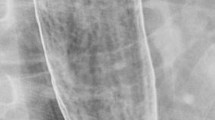Abstract
In Barrett's esophagus the normal stratified squamous epithelium of esophagus is replaced by columnar epithelium and other chracteristics of gastric mucosa. Barrett's esophagus has an increased tendency to bleed and is more prone to undergo malignant change. There are many procedures used to diagnose this entity, but only by serial and multiple esophageal mucosal biopsies can the diagnosis be confirmed. Harper et al (8) demonstrated an early and intense uptake of 99m Tc pertechnetate by the stomach in animals. Since the Barrett's esophagus is lined by gastric mucosa, pertechnetate scintigraphy was used as a screening procedure. The criteria for a positive scan was an area of increased uptake of technetium extending above the normal dense uptake of stomach configuration. Pertechnetate scintigraphy was performed in 4 patients with Barrett's esophagus and 6 controls with only one false negative result. Thus pertechnetate scintigraphy is a rapid, safe, and atraumatic screening procedure.
Similar content being viewed by others
References
Barrett NR: Chronic peptic ulcer of the oesophagus and oesophagitis. Br J Surg 38:175–182, 1950
Mangla JC, Kim YM, Guarasci G, Schenk EA: Pepsinogens in epithelium of Barrett's oesophagus. Gastroenterology 65:949–955, 1973
Goldman MC, Beckman RC: Barrett syndrome: Case report with discussion about concepts of pathogenesis. Gastroenterology 39:104–110, 1960
Desbaillets LG, Mangla JC: Endoscopic diagnosis of Barrett's esophagus. Endoscopy (to be published)
Adler RH, Rodriguez J: The association of hiatus hernia and gastroesophageal malignancy. J Thorac Surg 37:553, 1959
Smithers DW: Adenocarcinoma of the oesophagus. Thorax 11:257, 1956
Burgess JN, Payne WS, Andersen HA, Weiland LH, Carlson HC: Barrett esophagus: The columnar-epithelial-lined lower esophagus. Mayo Clin Proc 46:728–734, 1971
Harper PV, Andros G, Lathrop KA: Preliminary observations on the use of six-hour Tc99m as a tracer in biology and medicine. Semiannual report to the Atomic Energy Commission, September 1962. LO Jacobson (ed). ACRH-18, pp 76–87
Harden RMcG, Alexander WD, Kennedy I: Isotope uptake and scanning of the stomach in man with99mTc-pertechnetate. Lancet 1:1305–1307, 1967
Jewett TC Jr, Duszynski DO, Allen JE: The visualization of Meckel's diverticulum with99mTc-pertechnetate. Surgery 68:567–570, 1970
Duszynski DO, Jewett TC, Allen JE: Tc99mNa pertechnetate scanning of the abdomen with particular reference to small bowel pathology. Am J Roentgenol Radium Ther Nucl Med 113:250–262, 1971
Berquist TH, Nolan NG, Carlson HC, Stephens DH: Diagnosis of Barrett's esophagus by pertechnetate scintography. Mayo Clin Proc 48:276–279, 1973
Perlman J, Ruben S, Chaikoff IL: Radioactive phosphorus as an indicator of phospholipid metabolism. I. The rate of formation and destruction of phospholipids in the fasting rat. J Biol Chem 122:169–182, 1938
Jones HB, Chaikoff IL, Lawrence JH: Radioactive phosphorus as an indicator of phospholipid metabolism. X. The phospholipid turnover of fraternal tumors. J Biol Chem 133:319–327, 1944
Nakayama K: Diagnostic significance of radioactive isotopes in early cancer of the alimentary tract, especially the esophagus and the cardia. Surgery 39:736–759, 1956
Clode WH, Sobral JMV, Lima Basto E, Baptista AM: Elective uptake of radioiodine by cancer of the stomach. Surgery 50:725, 1961
Czerniak P, Bank H, Sinkower A, Adams R: Usefulness of radionuclides in evaluation of stomach disorders. Semin Nuclear Med 2:288–301, 1972
Marsden DS, Alexander C, Yeung P, Dunn A, Lazarevic B: Autoradiographic explanation for the uses of99mTc in gastric scintophotography. J Nucl Med 14:632, 1973
Gilday DL, Rosenthall L, Duszynski DO, James AE: Abdominal imaging in pediatrics. Pediatric Nuclear Medicine. AE James, HN Wagner, RE Cooke (eds). Philadelphia, W. B. Saunders, 1974, pp. 298–307
Meier-Ruge W, Fridrich R: Die verteilung von technetium99mund Tod-131 in her magenschleinhut. Histochemie 19: 147–154, 1969
Author information
Authors and Affiliations
Rights and permissions
About this article
Cite this article
Mangla, J.C., Brown, M. Diagnosis of Barrett's esophagus by pertechnetate radionuclide. Digest Dis Sci 21, 324–328 (1976). https://doi.org/10.1007/BF01071845
Issue Date:
DOI: https://doi.org/10.1007/BF01071845




